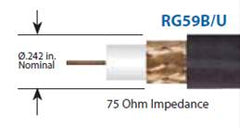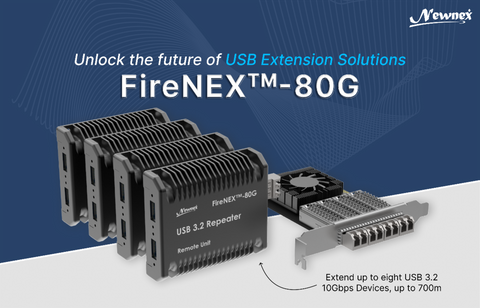What’s the right coaxial cable for your application?
Selecting the correct cable can go a long way toward satisfying the needs of a specific application. Which criteria are most important to the specifying process? There are 4 key points to be considered when choosing coaxial cables:

1. Cable Type
There are basically two types of coaxial cables: those with an impedance of 75 Ohms (Ω), used mostly for video applications, and those with an impedance of 50 Ω, used mostly for data and wireless communications.
Typical 75 Ω cables are our RG59/U and RG6/U. These cable types are available in 100-, 500- and 1000-foot reels.
Typical RG-style 50 Ω cables for data are RG174/U, RG188/U and RG316/U. These bulk cables can be used in applications where cable assemblies must be built in the field. Available in 100-, 500- and 1000-foot rolls, their stranded 26 AWG center conductors result in very flexible cables for tight-fit applications. Additionally, the bulk RG188A/U cable has a Teflon-taped outer jacket to help achieve a 200-degree C operating temperature, and the RG316/U has an extruded FEP outer jacket that helps achieve a 200-degree C operating temperature.
50 Ω cables can also be found in the low-loss category: 100-, 200-, and 400-series specifically for wireless applications. Low Loss coaxial cables provide far better shielding than their RG style counterparts and are best suited for RF applications.
2. Operating Frequency
Another important consideration is the operating frequency of the signal carried on the cable. As the frequency increases, the signal energy moves away from the cable's center conductor to the cable's shield outside of the conductor, a phenomenon known as the "skin effect".
This has a direct correlation to how far the signal can travel over a cable of a certain length, for a given signal frequency and power level. The higher the signal frequency, the shorter the distance traveled.
3. Cable Attenuation

Cable attenuation is the amount of signal loss over a specific distance. In general, the higher the frequency, the larger the attenuation will be. The larger the diameter of a cable's center conductor, the lower the attenuation is.
For example, an RG59/U cable with a 14 AWG center conductor can carry a signal (at a specific frequency and power level) about twice the distance as that of an RG11/U cable with a 20 AWG center conductor. It's imperative to know how much cable attenuation is acceptable in your particular application when selecting coaxial cable.
4. Characteristic Impedance
A coaxial cables characteristic impedance is an important parameter that affects the performance of the signal being carried over the cable. Also known as transmission impedance, it is defined as the relationship between a cable's capacitance per unit length to its inductance per unit length. For optimum signal transfer, the cable's characteristic impedance should be matched to the impedance/resistance of the load.
Quick note: RG-style coaxial cables are not all built the same. Check the specification requirements before you buy, and if you need help contact our technical support.

Introducing the FireNEX-80G USB Extension Systems, an innovative and secured extender solution for professional USB applications across industries including industrial automation, medical imaging, video conferencing, and more.
S
VPI's 26AWG CAT7 stranded SSTP Ethernet cables are now available in blue, white, gray, and black.

The F55 Cable Cubby is an elegant furniture-mounted, tilt‑up enclosure for professional environments that require AV connectivity, USB, data, control, and power in an attractive and streamlined solution.
Stuart Berry
Author